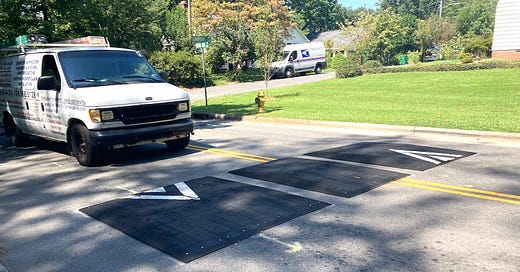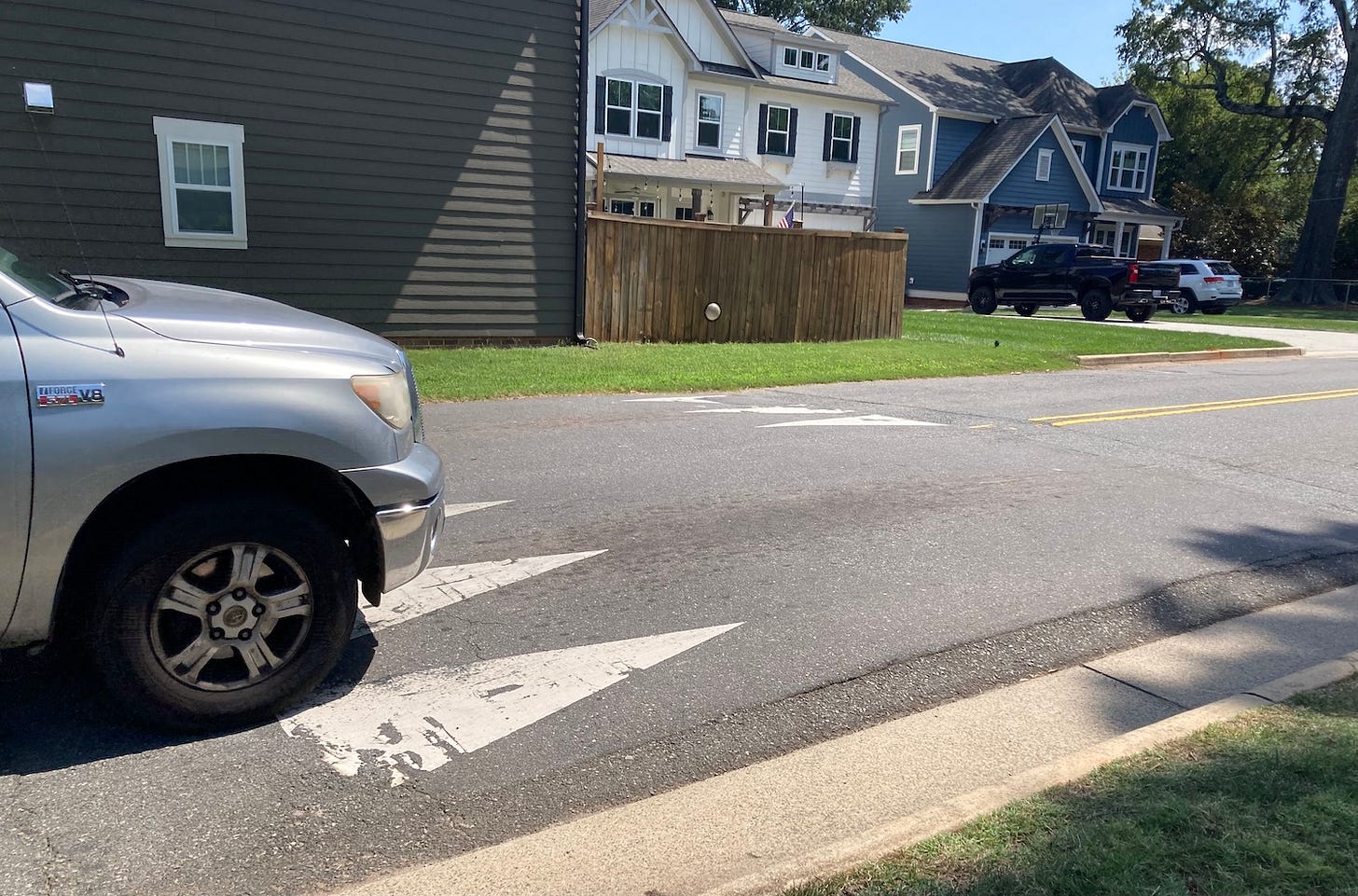The rubber is hitting the road
Help should soon be on the way for Charlotte neighborhoods wanting slower traffic
You’re reading Transit Time, a weekly newsletter for Charlotte people who leave the house. Cars, buses, light rail, bikes, scooters … if you use it to get around the city, we write about it. Transit Time is produced in partnership between The Charlotte Ledger and WFAE.
Transportation Summit on Monday: Transit Time is the media partner of the 2023 South Charlotte Partners Regional Transportation Summit — a gathering on Sept. 11 at The Ballantyne hotel that brings together federal, state and local policymakers to discuss trends in transportation and mobility. Find out more and get tickets here
Rubber ‘speed cushions’ are coming into vogue as Charlotte’s favored method to slow traffic on residential streets; 1/3 the cost of iconic asphalt ‘humps’
New kid on the block: Rubber “speed cushions” work similarly to asphalt speed humps, but at a fraction of the cost. This bad boy is on Woodland Drive, off Eastway Drive in east Charlotte.
By Tony Mecia
Speed humps, we salute you for your service.
But now, there’s a hot new traffic calming technology rolling out around town — one that’s cheaper, quicker to install and holds the promise of erasing the backlog of Charlotte neighborhoods that want traffic to slow down.
The newer arrival is called a “speed cushion.” It’s made of rubber, not asphalt. And it is poised to become the dominant way of slowing traffic in Charlotte’s neighborhoods.
“Going forward, I would expect to see more speed cushions than humps,” says David Smith, the engineering and operations division manager for the Charlotte Department of Transportation. Today, there are more asphalt humps than rubber cushions. The city estimates that there are nearly 2,000 speed humps or speed cushions on Charlotte streets.
Not all drivers love these bumps in the road that slow cars, but they have become popular in Charlotte neighborhoods — especially on streets that residents say are used by cut-through traffic.
The city started installing speed humps a little more than 25 years ago, and for much of that time, there has been a backlog of neighborhoods with qualifying streets that have had to wait. There are more than 100 locations in Charlotte on the waiting list for the devices.
The City Council last week approved two contracts for outside vendors to install speed humps and speed cushions: one with Carolina Cajun Concrete for “asphalt traffic calming device installation” and another with AWP Safety for “rubber speed cushion installation.”
“I really think we’re about to turn the corner and make some great progress on the backlog,” Smith says.
Asphalt speed humps, like this beauty on Walker Road off North Sharon Amity Road in south Charlotte, have been the workhorses of Charlotte traffic calming. But now they could be largely put out to pasture.
Rubber vs. asphalt
Rubber: In most cases, the rubber speed cushions should do the trick. They cost about $5,500 per installation and tend to be best for streets with traffic counts of between 600 and 5,000 vehicles a day. They don’t last as long as their asphalt cousins, but they are easier to deploy and can be configured so that emergency vehicles can pass through them without having to greatly slow down.
Asphalt: On the other hand, asphalt speed humps cost about $18,000 per installation and can last as long as the life cycle of a street, which is about 15 years. They tend to make the most sense on streets with more than 5,000 vehicles a day.
It’s rare to hit that traffic volume on most neighborhood streets. But Charlotte doesn’t want to abandon asphalt speed humps entirely.
“We want to keep both of the tools in the toolbox,” Smith said. “Your more traditional neighborhood streets, we suspect that rubber will be the better solution, but we want all the solutions available to us.”
Charlotte has nearly 2,000 speed humps or speed cushions (marked with blue dots), which have been installed in neighborhoods throughout the city since 1997. (Source: City of Charlotte Open Data Portal)
The city altered its policy on traffic calming last year to make it easier for residents to request speed humps (or cushions). Previously, the process involved gathering signatures from a certain number of property owners. Now, the city has made the process less formal and considers requests from residents who might be renters, not just owners. The city evaluates requests and sends notifications to nearby residents to gauge support.
To qualify, streets have to have:
at least 600 vehicles a day
a posted speed limit of 25 mph
an 85th percentile speed that’s more than 5 mph over the speed limit (in other words, 15% of drivers need to be going 30 mph or faster on a 25 mph street)
Smith said he figures that most residents who want traffic slowed in their neighborhoods are unfamiliar with the differences between speed humps and speed cushions.
“My guess would be most folks are not aware of the nuances, and that’s fine,” he says. “We’re here to be the experts on that.”
Tony Mecia is executive editor of The Charlotte Ledger. Reach him at tony@cltledger.com.
Related Transit Time articles:
“As Charlotte grows, is transportation funding keeping pace?” (March 17, 2022)
“How to cut down on Charlotte’s traffic deaths?” (Oct. 7, 2021)
In brief…
I-77 work at night: Southbound lanes on I-77 in Lake Norman will be closed at night starting tonight so construction crews can reconfigure the intersection and work on a bridge at Gilead Road (Exit 23). The nighttime closures could last through the month. (Observer)
New transportation secretary: N.C. Secretary of Transportation Eric Boyette is retiring and will be replaced by NCDOT’s chief operating officer, Joey Hopkins, on Oct. 1, Gov. Roy Cooper’s office said. (WRAL)
Speeding crackdown: Local law enforcement agencies handed out more than 400 traffic tickets on I-485 over Labor Day weekend. (WFAE)
Truck on the tracks: You don’t see this every day — A truck driving on the light rail tracks in South End. The Charlotte Area Transit System said there was no damage to the tracks:
Transit Time is a production of The Charlotte Ledger and WFAE. You can adjust your newsletter preferences on the ‘My Account’ page.
Did somebody forward you this newsletter and you need to sign up? You can do that here:
Other affiliated Charlotte newsletters and podcasts that might interest you:
The Charlotte Ledger Business Newsletter, Ways of Life newsletter (obituaries) and Fútbol Friday (Charlotte FC), available from The Charlotte Ledger.
The Inside Politics newsletter, available from WFAE.










